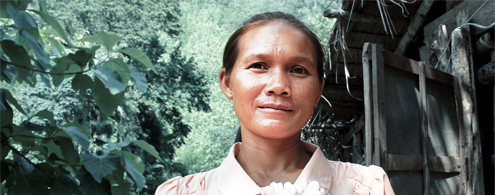Oyster mushrooms draw smiles on Phonxay District's farmers

Ms. Vieng, 32, can now proudly say that she is a mushroom farmer of Luang Prabang Province. A smile appears on her face when showing an oyster mushroom fruiting body from a bag she learned to prepare after participating in a training on mushroom cultivation with her group in Huayman, her native village in Phonexay District.
Together with three other village groups, she and other seven villagers from Huayman joined the cultivation group at the first stages in October 2014. From the onset, they learned how to prepare raw material with guidance of the Technical Service Center located in the neighboring village of Nambor. She immediately felt very motivated to take part in this new opportunity for her and her village.
Farmers in the area have a long tradition of collecting wild mushrooms for consumption, but they knew little about how to cultivate them. Organized by the Nambor Technical Center, the newly formed mushroom groups went on a study trip to learn from two other successful mushroom farmers in Luang Prabang. They quickly realized that oyster mushrooms are easily sold in the Luang Prabang markets at a price of 20-25,000 Kip per kg.
So when the Technical Service Center facilitators, in partnership with Ms. Viengkham, an expert from the Department of Agriculture of the Ministry of Agriculture and Forestry in Vientiane, suggested offering training to the villagers to cultivate oyster mushrooms, they all agreed.
It has been one year since Ms. Vieng joined the group. “As a result of the training her group has produced 1.5 tons of oyster mushrooms and now she spends less time in surrounding forests areas looking after food.” said Ms. Viengkham. The group has sold mushrooms totaling 20 million kip (USD 2,500) of which 60% is deposited in a local bank. Many villagers, like Ms. Vieng, now have an extra income to better support their children.
Now Ms. Vieng’s group has prepared the second round of bags and has begun to harvest them. This time the villagers are paying most of the production costs, but still each member is expected to earn two million kip.
Although the oyster mushroom is an easy species to cultivate much attention needs to be paid to avoid contamination at every step in the preparation, from sterilization of bagged raw material and inoculation, to keeping the houses clean. This is also the key message that Ms. Viengkham repeats at her regular visits to the four villages.
“ Huayman village is having a good performance, because the people well understood the simple sanitary rules like how to maintain optimal humidity through regular watering in the growing house. This has been key to success for the Huayman families, Ms. Viengkham says. “They were also very dedicated and interested and there is a good group solidarity. They even made a new growing house from their savings.” She added.
The oyster mushroom cultivation groups in Phonexay District have sparked interest and motivation of other villagers in the area. Mr. Hounpheng is a farmer that lives in Panma village, around 18 kilometers from the Nambor Technical Service Center. “When I learned about the groups, I asked the organizers to let me join and attend one training session and now I know how to cultivate them” he said, although he still needs money to buy equipment and a proper place to cultivate the mushrooms. “I would like to have a group organized in my village.” he commented.
The mushroom cultivation groups will have a third harvest in 2016 and thereafter they are expected to produce without the technical assistance from Ms. Viengkham.
Ms. Vieng feels that oyster mushroom cultivation has helped her a lot. She smiles and says: “I want to continue in the group, and from the earnings I also want to raise livestock.”
The Mushroom Cultivation group is supported by the Agro-Biodiversity Project, a GEF/UNDP funded initiative, technically supported by FAO.
Learn more about the Agro-Biodiversity Project
Related stories: Neglected no more: Extensive use of rich biodiversity in upland paddy rice ecosystem.
